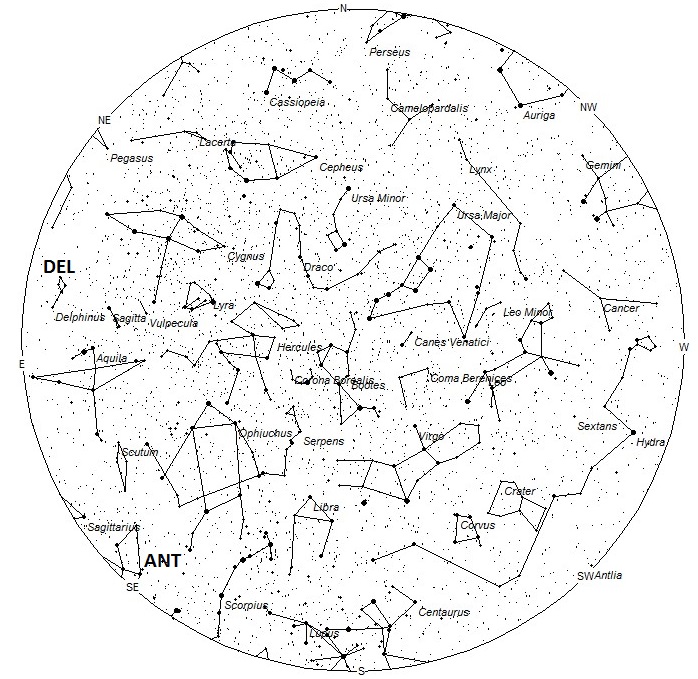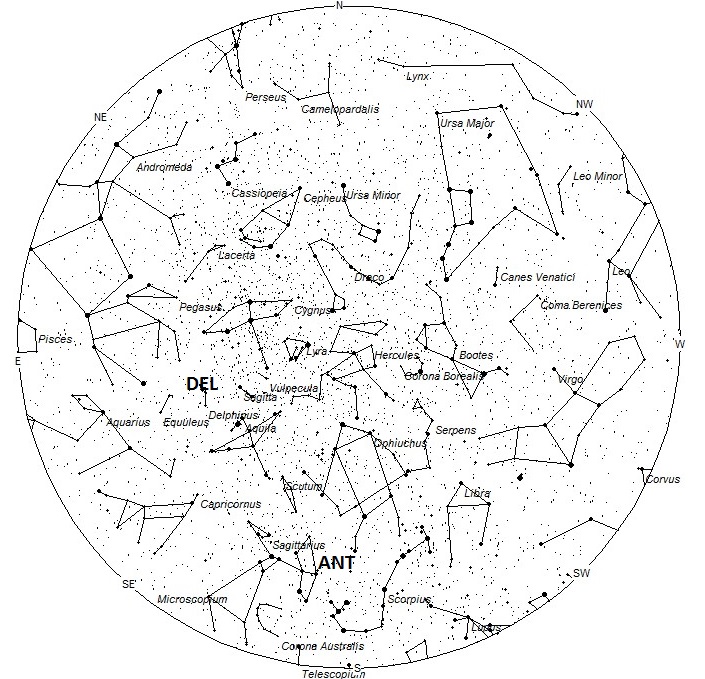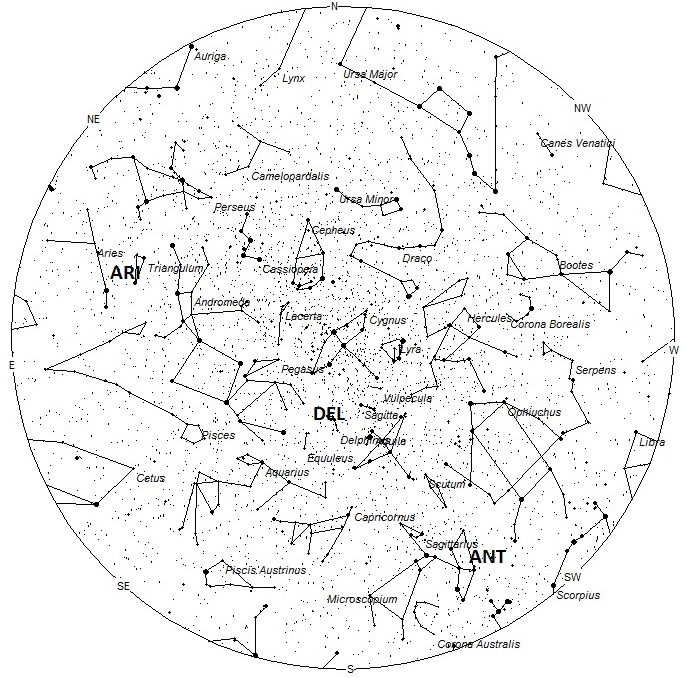June is another slow month for meteor activity. There are no major showers
active in June and only the Anthelion source can be counted on for continuous
activity. Even the Anthelion radiant is located so far south this time of year that
rates rarely exceed two per hour as seen from the northern hemisphere. Sporadic
rates begin a slow recovery in June as seen from the mid-northern hemisphere (45 N). Sporadic rates seen from the mid-southern hemisphere (45 S) continue to be strong this month before a big falloff occurs during the second half of July.
During this period the moon wanes from nearly half illuminated to almost its new phase. This weekend the bright crescent moon will be limited to the morning hours. Unfortunately this coincides with the most active time of night for viewing meteor activity. Moonlight can be overcome keeping the moon out of your field of view. As the week progresses, the situation improves with the moon getting thinner with each passing night. The estimated total hourly meteor rates for evening observers this week is near three as seen from the northern hemisphere and four as seen from south of the equator. For morning observers the estimated total hourly rates should be near six as seen from the northern hemisphere and fifteen as seen from the southern hemisphere. The actual rates will also depend on factors such as personal light and motion perception, local weather conditions, alertness and experience in watching meteor activity. Morning rates are reduced during this period due to moonlight.
The radiant (the area of the sky where meteors appear to shoot from) positions and rates listed below are exact for Saturday night/Sunday morning June 1/2. These positions do not change greatly day to day so the listed coordinates may be used during this entire period. Most star atlases (available at science stores and planetariums) will provide maps with grid lines of the celestial coordinates so that you may find out exactly where these positions are located in the sky. A planisphere or computer planetarium program is also useful in showing the sky at any time of night on any date of the year. Activity from each radiant is best seen when it is positioned highest in the sky, either due north or south along the meridian, depending on your latitude. It must be remembered that meteor activity is rarely seen at the radiant position. Rather they shoot outwards from the radiant so it is best to center your field of view so that the radiant lies at the edge and not the center. Viewing there will allow you to easily trace the path of each meteor back to the radiant (if it is a shower member) or in another direction if it is a sporadic. Meteor activity is not seen from radiants that are located below the horizon. The positions below are listed in a west to east manner in order of right ascension (celestial longitude). The positions listed first are located further west therefore are accessible earlier in the night while those listed further down the list rise later in the night.
The following showers are expected to be active this week:
The center of the large Anthelion (ANT) radiant is currently located at 17:36 (264) -23. This position lies in southeastern Ophiuchus , three degrees northeast of the third magnitude star known as Theta Ophiuchi. These meteors may be seen all night long but the radiant is best placed near 0200 LDT when it lies on the meridian and is highest in the sky. Rates at this time should be near two per hour as seen from the Northern hemisphere and three per hour from south of the equator . With an entry velocity of 30 km/sec., the average Anthelion meteor would be of slow velocity.
Besides the Anthelion radiant, the only shower of note active at this time is the Daytime Arietids (ARI). At 02:10 (044) +24, this radiant is located only thirty degrees west of the sun so visual observing conditions for this display are poor at best. It is an achievement of note just to see one of these meteors just before dawn on early June mornings. Your best chance to see this activity will occur on Friday morning June 7th, when this shower reaches maximum activity. On that morning start watching one hour before the start of dawn and look toward the northeast with your center of vision positioned half-way up in the sky. Any Arietids will shoot upwards from the horizon and should last several seconds as they streak a long path through the sky. Your chances of seeing these meteors are best from the northern tropics, where the longer nights allow the radiant to rise higher into the sky. At 43km/sec. the Daytime Arietids would produce meteors of medium velocity. By the way, this is the strongest daylight shower of the year. If the circumstances were better for this shower (higher radiant in a dark sky), this display would rival the annual Perseids in intensity.
As seen from the mid-northern hemisphere (45N) one would expect to see approximately four sporadic meteors per hour during the last hour before dawn as seen from rural observing sites. Evening rates would be near two per hour. As seen from the mid-southern hemisphere (45S), morning rates would be near twelve per hour as seen from rural observing sites and three per hour during the evening hours. Locations between these two extremes would see activity between the listed figures. Morning rates are reduced due to moonlight.
The table below presents a list of radiants that are expected to be active this week. Rates and positions are exact for Saturday night/Sunday morning.
| SHOWER | DATE OF MAXIMUM ACTIVITY | CELESTIAL POSITION | ENTRY VELOCITY | CULMINATION | HOURLY RATE | CLASS |
| RA (RA in Deg.) DEC | Km/Sec | Local Daylight Time | North-South | |||
| Anthelions (ANT) | – | 17:36 (264) -23 | 30 | 02:00 | 2 – 3 | II |
| Daytime Arietids (ARI) | Jun 07 | 02:10 (044) +24 | 43 | 10:00 | <1 – <1 | IV |
 American Meteor Society
American Meteor Society



Bob,
I reported the fireball seen from Lititz, PA at 9:50pm Easter on 6/1/13. I submitted a picture, but I do not yet see it listed on the sight under Photos. The photo that I took is spectacular when it is zoomed. It actually looks like a small sun as you can see the flames around the edges.
Also, this is the first fireball that I have seen. What was there not a visible trail and why did it appear to be traveling so slow?
I saw a fireball over herscher, il area at 0325 local time. It lit up the sky for 5-7 seconds. It broke apart into atleast a dozen pieces and shined as bright as a full moon even though there was moderate cloud cover. It left a bluish-green trail.. Anyone report this?
I also saw this fireball in the Southern Sky while driving home. I was in Plainfield Illinois at the time. About 3:25 am. It was very bright. It was breaking up and did not appear miles up in the sky like I’ve seen before during meteor showers.
Whatever it was, it I saw it too, it was large.
Kendall,
Check out the AMS fireball table at: http://www.amsmeteors.org/fireball_event/2013/ and compare reports listed there to yours.
I hope this helps!
Robert Lunsford
I saw a fireball around 1230a EST on Fri night (06.07) /(06/08)Sat morning. It seemed to hover awhile (maytbe 1 minute or so from the time I noticed it) over my neighborhood then slowly took off in a southerly direction speeding up as it moved southward. It was out of sight in about 15 seconds.
Hello all, this is my first post and really don’t know anything about these types of things, so please bear with me. This past Saturday night my brother and I were driving back to my home in Belmont, North Carolina about 1130PM when I looked up to the sky to see a VERY scary site. There were TWO huge fireballs with tails behind them. We slammed on the brakes and jumped out of the truck and watched them. They moved very slowly and looked like they were moving in some form of a formation, my brother tought they might have been some kind of secret aircraft or something, but they were on fire. I don’t know what they were, I just was wondering if anyone else saw them, so I know I’m not crazy. Thanks Jeremy